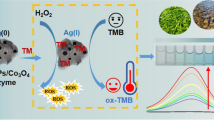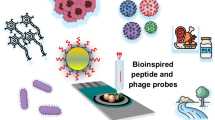Abstract
Herein, a novel signal-on photoelectrochemical (PEC) biosensor with nearly zero background noise (ZBN) was first fabricated to determine the presence of organophosphorus pesticide based on in situ formation of DNA-templated Ag2S photoactive materials, accompanied by hybridization chain reaction (HCR) signal amplification. The capture probe (S1) on the gold nanoparticle-modified electrode can hybridize with the aptamer molecule to generate a simple PEC biosensor. In the presence of a target molecule, the aptamer molecule is released on the double-stranded DNA (dsDNA)-modified PEC biosensor. Meanwhile, the capture probe remains on the electrode and can open the DNA hairpins (H1, H2) which are rich in cytosine, to trigger the HCR reaction. The rich “C” strands are uncovered after formation of a long dsDNA polymer strand, which can assemble multiple silver ions (Ag+) by means of by C–Ag+–C chelation. Then, a large number of Ag2S can be generated by challenging with S2− solution, producing a satisfactory photocurrent signal. The photoactive material is formed in situ, which eliminates the laborious operation. Moreover, the signal can be highly amplified with nearly zero background noise and HCR signal amplification. Under optimal conditions, the ZBN aptasensor exhibited high sensitivity and selectivity, with a low detection limit of 2 pg mL−1 for malathion. Importantly, the sensing platform can also be applied to determine the presence of malathion in real samples.
Graphical abstract

In this assay, a novel signal-on photoelectrochemical biosensor with nearly zero background noise was first fabricated to determine the presence of organophosphorus pesticide based on in situ formation of DNA-templated Ag2S photoactive materials, accompanied by hybridization chain reaction signal amplification.






Similar content being viewed by others

References
Yao T, Liu A, Liu Y, Wei M, Wei W, Liu S. Ratiometric fluorescence sensor for organophosphorus pesticide detection based on opposite responses of two fluorescence reagents to MnO2 nanosheets. Biosens Bioelectron. 2019;145:111705.
Zhang J, Fang X, Wu J, Hu Z, Jiang Y, Qi H, et al. An interdigitated microelectrode based aptasensor for real-time and ultratrace detection of four organophosphorus pesticides. Biosens Bioelectron. 2019;150:111879.
Li J, Xiong P, Tang J, Liu L, Gao S, Zeng Z, et al. Biocatalysis-induced formation of BiOBr/Bi2S3 semiconductor heterostructures: a highly efficient strategy for establishing sensitive photoelectrochemical sensing system for organophosphorus pesticide detection. Sens Actuators B Chem. 2021;331:129451.
Long Q, Li H, Zhang Y, Yao S. Upconversion nanoparticle-based fluorescence resonance energy transfer assay for organophosphorus pesticides. Biosens Bioelectron. 2015;68:168–74.
Chen J, Chen X, Zhao J, Liu S, Chi Z. Instrument-free and visual detection of organophosphorus pesticide using a smartphone by coupling aggregation-induced emission nanoparticle and two-dimension MnO2 nanoflake. Biosens Bioelectron. 2020;170:112668.
Zhang SX, Xue SF, Deng J, Zhang M, Shi G, Zhou T. Polyacrylic acid-coated cerium oxide nanoparticles: an oxidase mimic applied for colorimetric assay to organophosphorus pesticides. Biosens Bioelectron. 2016;85:457–63.
Wang J, Chow W, Leung D, Chang J. Application of ultrahigh-performance liquid chromatography and electrospray ionization quadrupole orbitrap high-resolution mass spectrometry for determination of 166 pesticides in fruits and vegetables. J Agric Food Chem. 2012;60(49):12088–104.
Cacho JI, Campillo N, Vinas P, Hernandez-Cordoba M. In situ ionic liquid dispersive liquid-liquid microextraction coupled to gas chromatography-mass spectrometry for the determination of organophosphorus pesticides. J Chromatogr A. 2018;1559:95–101.
Yao C, Cheng F, Wang C, Wang Y, Guo X, Gong Z, et al. Separation, identification and fast determination of organophosphate pesticide methidathion in tea leaves by thin layer chromatography–surface-enhanced Raman scattering. Anal Methods. 2013;5(20):5560–4.
Olsson AO, Baker SE, Nguyen JV, Romanoff LC, Udunka SO, Walker RD, et al. A liquid chromatography−tandem mass spectrometry multiresidue method for quantification of specific metabolites of Organophosphorus pesticides, synthetic Pyrethroids, selected herbicides, and DEET in human urine. Anal Chem. 2004;76(9):2453–61.
Liu Y, Yan K, Zhang J. Graphitic carbon nitride sensitized with CdS quantum dots for visible-light-driven Photoelectrochemical Aptasensing of tetracycline. ACS Appl Mater Interfaces. 2016;8(42):28255–64.
Zhang L, Shen YL, Fan GC, Xiong M, Yu XD, Zhao WW. Preparation of an AgI/CuBi2O4 heterojunction on a fluorine-doped tin oxide electrode for cathodic photoelectrochemical assays: application to the detection of L-cysteine. Mikrochim Acta. 2019;186(5):284.
Shu J, Tang D. Recent advances in Photoelectrochemical sensing: from engineered photoactive materials to sensing devices and detection modes. Anal Chem. 2020;92(1):363–77.
Tang J, Li J, Xiong P, Sun Y, Zeng Z, Tian X, et al. Rolling circle amplification promoted magneto-controlled photoelectrochemical biosensor for organophosphorus pesticides based on dissolution of core-shell MnO2 nanoflower@CdS mediated by butyrylcholinesterase. Mikrochim Acta. 2020;187(8):450.
Hao N, Hua R, Chen S, Zhang Y, Zhou Z, Qian J, et al. Multiple signal-amplification via Ag and TiO2 decorated 3D nitrogen doped graphene hydrogel for fabricating sensitive label-free photoelectrochemical thrombin aptasensor. Biosens Bioelectron. 2018;101:14–20.
Li J, Yin O, Zhao L, Wang Z, Dong B, Wan L, et al. Enhancing the photoelectric conversion efficiency of dye-sensitized solar cell using the upconversion luminescence materials Y2O3:Er3+ nanorods doped TiO2 photoanode. Materials Letters. 2018;227:209–12.
Qian Y, Feng J, Xu R, Fan D, Du Y, Ren X, et al. Zinc and molybdenum co-doped BiVO4 Nanoarray for Photoelectrochemical diethylstilbestrol analysis based on the dual-competitive system of manganese Hexacyanoferrate hydrate Nanocubes. ACS Appl Mater Interfaces. 2020;12(14):16662–9.
Tayebi M, Tayyebi A, Masoumi Z, Lee B-K. Photocorrosion suppression and photoelectrochemical (PEC) enhancement of ZnO via hybridization with graphene nanosheets. Applied Surface Science. 2020;502:144189.
Yang X, Zhang M, Chen Z, Bu Y, Gao X, Sui Y, et al. Sodium alginate micelle-encapsulating zinc Phthalocyanine dye-sensitized Photoelectrochemical biosensor with CdS as the photoelectric material for Hg2+ detection. ACS Appl Mater Interfaces. 2021;13(14):16828–36.
Tang J, Cheng Y, Zheng J, Li J, Sun Y, Peng S, et al. Target-engineered photo-responsive DNA strands: a novel signal-on photoelectrochemical biosensing platform for ochratoxin a. Anal Methods. 2019;11(43):5638–44.
Da H, Liu H, Zheng Y, Yuan R, Chai Y. A highly sensitive VEGF165 photoelectrochemical biosensor fabricated by assembly of aptamer bridged DNA networks. Biosens Bioelectron. 2018;101:213–8.
Da H, Liu Y, Li M, Yuan R, Liu H, Chai Y. A highly sensitive photoelectrochemical VEGF165 biosensor with a dual signal amplification strategy by using AgVO3 as a photoactive material. Chem Commun. 2019;55(56):8076–8.
Xiao K, Meng L, Du C, Zhang Q, Yu Q, Zhang X, et al. A label-free photoelectrochemical biosensor with near-zero-background noise for protein kinase a activity assay based on porous ZrO2/CdS octahedra. Sens Actuators B Chem. 2021;328:129096.
Li M, Xiong C, Zheng Y, Liang W, Yuan R, Chai Y. Ultrasensitive Photoelectrochemical biosensor based on DNA tetrahedron as Nanocarrier for efficient immobilization of CdTe QDs-methylene blue as signal probe with near-zero background noise. Anal Chem. 2018;90(13):8211–6.
Shen H, Jiao X, Oron D, Li J, Lin H. Efficient electron injection in non-toxic silver sulfide (Ag2S) sensitized solar cells. Journal of Power Sources. 2013;240:8–13.
Li R, Tu W, Wang H, Dai Z. Near-infrared light excited and localized surface Plasmon resonance-enhanced Photoelectrochemical biosensing platform for cell analysis. Anal Chem. 2018;90(15):9403–9.
Mirahmadi FS, Marandi M, Karimipour M, Molaei M. Microwave activated synthesis of Ag2S and Ag2S@ZnS nanocrystals and their application in well-performing quantum dot sensitized solar cells. Sol Energy. 2020;202:155–63.
Kozhevnikova NS, Vorokh AS, Shalaeva EV, Baklanova IV, Tyutyunnik AP, Zubkov VG, et al. One-pot inorganic route to highly stable water-dispersible Ag2S quantum dots. J Alloys and Compd. 2017;712:418–24.
Lu F, Ju W, Zhao N, Zhao T, Zhan C, Wang Q, et al. Aqueous synthesis of PEGylated Ag2S quantum dots and their in vivo tumor targeting behavior. Biochem Biophys Res Commun. 2020;529(4):930–5.
Liu D, Lai J, Wang R, Ye L, Tian Y. Reverse microemulsion synthesis of Fe3O4–Ag2S Heteronanocrystals for dual-modal imaging-guided Photothermal tumor ablation. ACS Biomater Sci Eng. 2019;5(11):6196–206.
Zhai LY, Li MX, Pan WL, Chen Y, Li MM, Pang JX, et al. In situ detection of plasma Exosomal MicroRNA-1246 for breast Cancer diagnostics by a au Nanoflare probe. ACS Appl Mater Interfaces. 2018;10(46):39478–86.
Yuan Y, Hu T, Zhong X, Zhu M, Chai Y, Yuan R. Highly sensitive Photoelectrochemical biosensor based on quantum dots sensitizing Bi2Te3 Nanosheets and DNA-amplifying strategies. ACS Appl Mater Interfaces. 2020;12(20):22624–9.
Yu X, Zhang ZL, Zheng SY. Highly sensitive DNA detection using cascade amplification strategy based on hybridization chain reaction and enzyme-induced metallization. Biosens Bioelectron. 2015;66:520–6.
Yao GH, Liang RP, Yu XD, Huang CF, Zhang L, Qiu JD. Target-triggering multiple-cycle amplification strategy for ultrasensitive detection of adenosine based on surface plasma resonance techniques. Anal Chem. 2015;87(2):929–36.
Guo J, Wang J, Zhao J, Guo Z, Zhang Y. Ultrasensitive multiplexed immunoassay for tumor biomarkers based on DNA hybridization chain reaction amplifying signal. ACS Appl Mater Interfaces. 2016;8(11):6898–904.
Lu L, Wang J, Miao W, Wang X, Guo G. Electrogenerated Chemiluminescence biosensor with a tripod probe for the highly sensitive detection of MicroRNA. Anal Chem. 2019;91(2):1452–9.
Li H, Wang J, Wang X, Lin H, Li F. Perylene-based photoactive material as a double-stranded DNA intercalating probe for ultrasensitive Photoelectrochemical biosensing. ACS Appl Mater Interfaces. 2019;11(18):16958–64.
Qiu Z, Shu J, Tang D. NaYF4:Yb,Er Upconversion Nanotransducer with in Situ Fabrication of Ag2S for Near-Infrared Light Responsive Photoelectrochemical Biosensor. Anal Chem. 2018;90(20):12214–20.
Sun Y, Xiong P, Tang J, Zeng Z, Tang D. Ultrasensitive split-type electrochemical sensing platform for sensitive determination of organophosphorus pesticides based on MnO2 nanoflower-electron mediator as a signal transduction system. Anal Bioanal Chem. 2020;412(25):6939–45.
Zhang S, Wang J, Chen S, Li R, Peng T. Construction of Ag2S/WO3 direct Z-scheme Photocatalyst for enhanced charge separation efficiency and H2 generation activity. Ind Eng Chem Res. 2019;58(32):14802–13.
Ge S, Lan F, Liang L, Ren N, Li L, Liu H, et al. Ultrasensitive Photoelectrochemical biosensing of cell surface N-glycan expression based on the enhancement of Nanogold-assembled Mesoporous silica amplified by Graphene quantum dots and hybridization chain reaction. ACS Appl Mater Interfaces. 2017;9(8):6670–8.
He Z-J, Kang T-F, Lu L-P, Cheng S-Y. An electrochemiluminescence aptamer sensor for chloramphenicol based on GO-QDs nanocomposites and enzyme-linked aptamers. J Electroanal Chem. 2020;860:113870.
Thakur B, Bernalte E, Smith J, Linton P, Sawant S, Banks C, et al. The Mediatorless Electroanalytical sensing of sulfide utilizing unmodified graphitic electrode materials. C. 2016;2(2):14.
Rodrigues NFM, Neto SY, Luz RCS, Damos FS, Yamanaka H. Ultrasensitive determination of Malathion using Acetylcholinesterase immobilized on chitosan-functionalized magnetic Iron nanoparticles. Biosensors (Basel). 2018;8(1):16.
Bolat G, Abaci S. Non-enzymatic electrochemical sensing of Malathion pesticide in tomato and apple samples based on gold nanoparticles-chitosan-ionic liquid hybrid Nanocomposite. Sensors (Basel). 2018;18(3):773.
Li D, Wang S, Wang L, Zhang H, Hu J. A simple colorimetric probe based on anti-aggregation of AuNPs for rapid and sensitive detection of malathion in environmental samples. Anal Bioanal Chem. 2019;411(12):2645–52.
Chauhan N, Narang J, Pundir CS. Immobilization of rat brain acetylcholinesterase on porous gold-nanoparticle-CaCO3 hybrid material modified au electrode for detection of organophosphorous insecticides. Int J Biol Macromol. 2011;49(5):923–9.
Soomro RA, Hallam KR, Ibupoto ZH, Tahira A, Sherazi STH, Sirajjuddin MSS, et al. Amino acid assisted growth of CuO nanostructures and their potential application in electrochemical sensing of organophosphate pesticide. Electrochim Acta. 2016;190:972–9.
Huo D, Li Q, Zhang Y, Hou C, Lei Y. A highly efficient organophosphorus pesticides sensor based on CuO nanowires–SWCNTs hybrid nanocomposite. Sens Actuators B Chem. 2014;199:410–7.
Antunes R, Ferraz D, Garcia L, Thomaz D, Luque R, Lobón G, Gil E, Lopes F. Development of a polyphenol oxidase biosensor from Jenipapo fruit extract (Genipa americana L.) and determination of phenolic compounds in textile industrial effluents. Biosensors (Basel). 2018;8(2):47.
Acknowledgements
This work was financially supported by the National Natural Science Foundation of China (21864013), the Science Foundation for Excellent Young Scholars of Jiangxi Province (20202ZDB01003), the Natural Science Foundation of Jiangxi Province (20202BAB203008), and the Postdoctoral Science Foundation of Jiangxi Province (2019KY40).
Author information
Authors and Affiliations
Corresponding author
Ethics declarations
Conflict of interest
The authors declare no competing interests.
Additional information
Publisher’s note
Springer Nature remains neutral with regard to jurisdictional claims in published maps and institutional affiliations.
Rights and permissions
About this article
Cite this article
Zeng, Z., Tang, J., Zhang, M. et al. Ultrasensitive zero-background photoelectrochemical biosensor for analysis of organophosphorus pesticide based on in situ formation of DNA-templated Ag2S photoactive materials. Anal Bioanal Chem 413, 6279–6288 (2021). https://doi.org/10.1007/s00216-021-03582-3
Received:
Revised:
Accepted:
Published:
Issue Date:
DOI: https://doi.org/10.1007/s00216-021-03582-3



